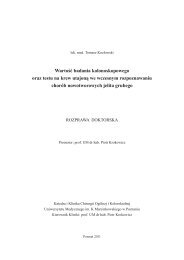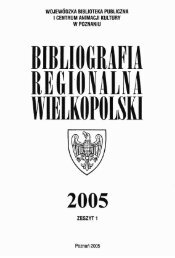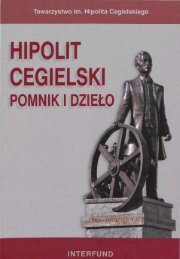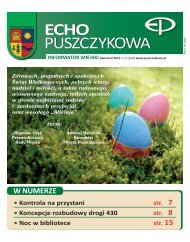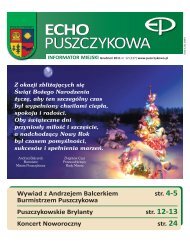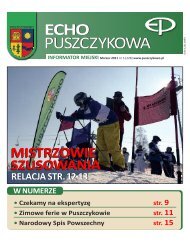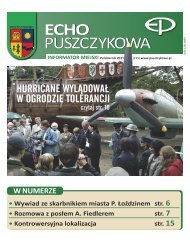MILITARY PHARMACY AND MEDICINE
MILITARY PHARMACY AND MEDICINE
MILITARY PHARMACY AND MEDICINE
You also want an ePaper? Increase the reach of your titles
YUMPU automatically turns print PDFs into web optimized ePapers that Google loves.
© Military Pharmacy and Medicine • 2012 • 4 • 83 – 86indicate male sex of the deceased. Unfortunately,no postcranial skeleton was found [12].A large bone fragment was removed posthumouslyfrom the skull: a fragment of coronalsuture (coronal suture forms a border of the orifice,suture pattern is visible at the superior margin),part of the right parietal bone and a largefragment of left occipital bone, reaching all theway to the left temporal bone. Opening encompassesalmost entire sagittal suture (a fragmentof sagittal suture is visible as it joins with lambdoidsuture) and has the following dimensions:102x94mm (external lamina) and 95x84mm(internal lamina). Possibly, such large skull fragmentwas removed for bone amulets or a drinkinggoblet (such practice was known in the MiddleAges and previous eras). Thus, this procedurewas performed after persons’ death for magicalreasons. In Middle Ages, bones of the deadand pieces of their clothing were often used formagical or therapeutic purposes. They were usedfor bewitchments. We can present an exampleof such procedure from Lithuania, where fourfemale skulls (14 th -16 th century) were found withround orifices performed posthumously. Bonefragments serving as amulets were acquired thisway [13]. There is a suspicion that in folk medicine,human skull grated into powder, servedwith food or drinks, was considered treatmentfor some aliments [14].There is also another possible explanation. Suchlarge opening was done in order to look insidethe human head and curiosity was the reasonfor post-mortem examination. The margin ofthe orifice is uneven and jagged, particularly onthe right side, while the inferior orifice marginis evenly filed off. Part of calvaria was probablyremoved using a saw (sharp and smooth) and thebone was broken at the coronal suture.A canon from Opole, master Pawel, who servedas a town physician in 1261, was mentioned inpublished documents [15]. Opole lies near Wroclaw,which in the Middle Ages was the focus ofqualified physicians. The doctors acknowledgedin written sources practiced in Cracow, Bytomand Glogow in the 14 th century. Names of doctorswho practiced in Silesia were also preserved:Tomasz — the titular Bishop of Serepta, Jan ofGrodkow, Jan of Glogau. There were two centersMagdalena Cybulska at al.: Autopsy marks on anthropological material …of development of Polish medicine in the 14th-15 th century – Cracow and Wroclaw [9].The second skull in question (also containinga large opening) comes from the St. NicholasChurch in Torun. Skeletons found duringarcheological excavations are dated to 14th and18th century. A large, oval fragment of calvaria,including a fragment of left and right parietalbones and posterior part of frontal bone wereremoved from a male skull. Body of the sternumwas also cut with a sharp instrument, which maybe an evidence of attempted removal of internalorgans [16]. The person performing the autopsywas probably not very experienced in suchmaneuvers. Orifice margins are quite even, thus asharp tool with a smooth blade was possibly usedand tool marks are visible on the edges of theopening. Superior part of the skull (entire cranialvault) was sawn off, while the posterior portion offrontal bone lamina was broken off. In this case,the resected bone was found together with theskull and only the fragment of broken off frontalbone is lacking. The 15 th century documentsmention a doctor who practiced in the region ofTorun. This autopsy may be also related to theactivity of the Academic Gymnasium in Torun,which offered anatomy lectures. This facility wascreated in the 16th century, but its developmentfalls on the period of 17 th century.Similar skulls from 16 th and 18 th century bearingtraces of autopsies (the superior part of calvariawas also removed) were discovered at theexcavation site in Holy Spirit in Brzesc Kujawski(Kujawsko-Pomorskie Province). There were atotal of 5 such skulls excavated at cemeteries nearthe hospital and the church. An iron saw wasprobably used here to remove calvaria [17]. Functioningof the first hospital in Brzesc is dated to13 th -14 th century. Medieval hospitals functionedmainly as shelters, taking care of the poor andill travelers. With time, since renaissance, theygained increasingly more medical character.Another skull, which is an example of post-mortemexamination, was dug out from a cemeteryin Dabrowna (Warmia and Mazury Province)dated to 14 th -17 th century. It belonged to an adultmale. Calvaria was removed (part of frontal bone,large fragments of parietal bones, part of occipitalbone) using a metal saw — the cut ran over thehttp://military.isl-journals.com83



